
Hotline SOTA “Corona Impact” SOTA. The results.

From time to time, Flanders Arts Institute opens up her online channels for guest contributions. The number crunching analysis below is a description of the results of the hotline SOTA installed to gauge the impact of the Corona crisis. An analysis like that aids Flanders Arts Institute, and others, to better grasp the impact. Therefore, we gladly share this guest contribution of State of the Arts, penned by Wouter Hillaert.
On the 14th of March, 24h after the start of the lockdown, State of the Arts (SOTA) launched a hotline where individual cultural workers could testify about their situation and expected loss of income. In 4 weeks, the hotline received almost 800 reactions. Here we share some figures, insights and general conclusions.
Important to start with: the hotline was launched to gather first impressions about the impact of the lockdown on individual cases. Within four days, some of these testimonies were used for the article ‘The financial battlefield named corona’. Respondents were asked to share their lost income, but in general concrete figures were not the first ambition of this hotline. It was mostly launched for journalistic reasons.
So please take into account:
- Most testimonies were shared before several governmental compensation regulations were announced.
- The first testimonies only reported losses for the period until the 3rd of April, later testimonies also took in account canceled activities up until May.
- The survey didn’t ask to specify net or gross amounts of lost revenues. We assume most reported amounts were gross, but some probably will be net. Our figures give a general idea.
Still we can draw some interesting and representative general conclusions about:
- the impact of this corona crisis on the socio-economical situation of individual cultural workers (the few reported losses of organisations were taken out): not only artists, but also technicians, cultural educators, bookers, cultural journalists… (active in both commercial and state supported culture)
- the specific working conditions and ratios within the cultural field
SOTA’s main findings
- 725 cultural workers (10% did not answer this question) report an average loss of revenues of 5.563 euro gross, the median is 3.300 euro. Together they report a total loss of revenues of 4,03 million euro.
- The average and median amounts of reported losses are quite similar in different disciplines. Only in the film- and television sector the average and median loss is much higher: 12.422 euro (median 8.000 euro). See our interpretation below.
- Lost revenues reported after the first week of the lockdown (14–21th of March) are in average 60 to 70% higher than during the first week: the rising losses of income due to more and more canceled activities after March/April (also in May/June…) are not compensated by rescheduled activities.
- Although 70% of all respondents work in only one social statute, in total 36 different combinations of statutes were reported: a clear indication of the complex job situation in the cultural field (mostly in music and performing arts).
- Fully self-employed cultural workers (one third of the respondents) have lost most revenues (10.700 euro gross in average), but could recuperate 52% to 58% of this average income loss by the special support regulations of the different governments.
- Partly self-employed cultural workers (mostly musicians) report an average gross loss of 5.263 euro. They have access to the same compensation measures of full-time self employed workers if they pay social security taxes on the minimum level of full-timers, but this condition is not realistic for the bulk of the artists in this category. If they don’t pay social security but have an income in between 6.996 and 13.994 euro per year, they can also get a one-time forfait of 1.500 euro. That counts for 28% of the average lost revenues that were reported by this group.
- The most vulnerable group of artists working with short contracts, without any other statute to rely on (and an average loss of revenues between 3.600 and 3.900 euro), is the biggest in film and television (31%) and in visual arts (23%). In music and performing arts, they count for 12%. Many of them are not helped yet by the actual support measures by the government, read some testimonies here (in Dutch). In performing arts 21% uses these short contracts with the ‘artists statute’ that will also come under pressure as the impact of the crisis persists.
Figures and interpretations
1. Who has been reporting when?
- In total the hotline received 794 reactions from individual cultural workers.

- 44% of the reactions are from (both pop and classical) musicians, but also from music technicians, music bookers, production people…
- The category ‘other’ shows the broad variety of job profiles linked to culture and affected by the lockdown: event-management, cultural journalists, art educators (workshops), set designers, sound and light rental, graphic designers, stylists, freelance communication…

- More than 50% of the reactions (425) came in the 3 first days of the hotline: when there was not yet any information about rescheduled activities, and the lockdown still was limited to the 3rd of April. So half of the cultural workers only testified about canceled activities and financial losses for the month of March.
- More than 75% of the reactions (627) were posted in the first week of the lockdown (14–21 March).
- Less than 25% of the reactions came after that first week (21 March — 9 April) and took also into account new canceled activities for April and May (and eventually already rescheduled activities).
- On average the reported financial losses were remarkably higher in this later group: Week 1: an average of 4.578 euro gross per person, median 2.510 euro; Week 2–4: an average of 7.843 euro gross per person, median 4.000 euro.
=> Losses rise (quickly) in time (+60–70%), due to more and more cancellations…
2. Which amount(s) are lost by cultural workers?
The average amount of reported lost revenues is 5.563 euro gross, the median is 3.300 euro. Together all 725 (of 794) respondents that filled in an amount of lost income, report a total loss of revenues of 4,03 million euro. We assume that many of these reported amounts are invoice prices: the net income they represent is possibly only half of it.
The reported losses of income per respondent show a broad variety:

- These columns show different scales of lost revenues (per thousand euro): 0 = 0–999 euro, 1 = 1.000–1.999 euro, 2 = 2.000–2.999 euro…
- 47% of all 725 respondents report financial losses between 0 and 3.000 euro gross. This suggests that for many cultural workers the loss of income seems rather small, but one should take into account:
- Most of the reported losses only apply for March (meanwhile these amounts certainly have become higher for 75% of the respondents, see above)
- These ‘smaller’ amounts do not mean that this group will overcome the cultural lockdown more easily: many artists and cultural workers live in precarious economical situations. A loss of ‘only’ 2.000 euro can make a big difference in paying the rent or not.
- The highest reported amounts (+ 20.000 euro) are not indicated in this chart, but the big gap between the average and the median amount of lost revenues indicate that there’s a small group (3%, 25 respondents) that loses much bigger amounts of money. The biggest personal loss that was reported is 75.000 euro gross, from a visual artist that could not exhibit and sell his works (probably investments of several months) because Art Brussels got canceled.
Indeed, the size and type of lost revenues can vary from discipline to discipline:
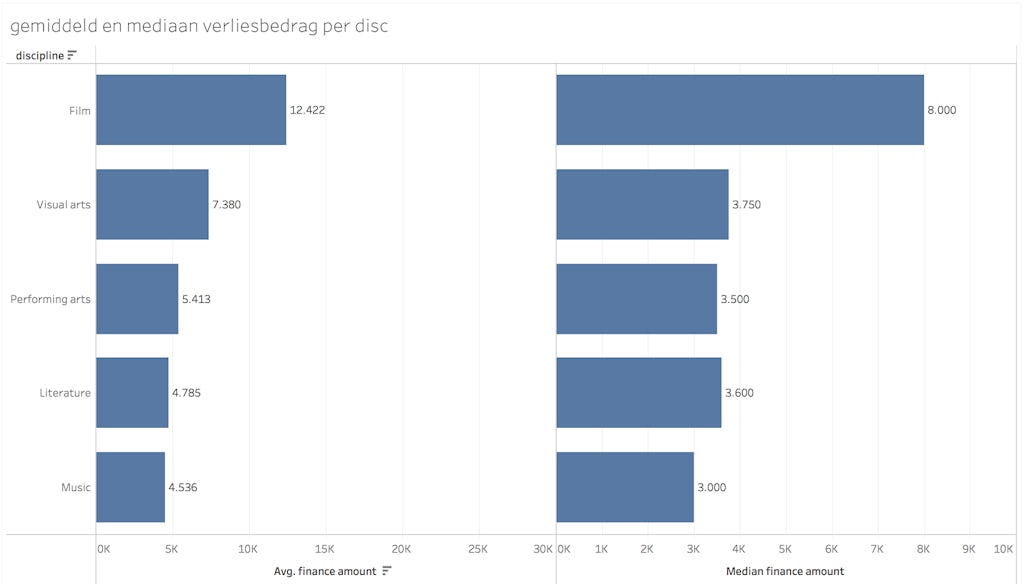
- The left chart shows average amounts of lost revenues per discipline, the right chart shows the median in every discipline.
- The median in most disciplines varies between 3.000 and 3.750 euro gross: the structure and variety of lost revenues are rather similar in visual arts, music, performing arts and literature.
- Only the 38 respondents from the film and television sector (5%) report a much bigger amount of lost revenues (483.000 euro gross = 12% of the total 4 million). It’s a sector with bigger budgets and longer job periods, where a canceled film set immediately has a huge impact on the production houses involved.
3. Different statutes = different effects
As different cultural workers — and some of them in complete panic — testify that they end up with no income at all for weeks or even months, the key question is to what extent they can benefit from the different support regulations by the federal and the Flemish government. The answer to that question depends on the very complex variety of social statutes in the cultural field. For different statutes, different regulations were announced. How do they match the social situation of these 794 respondents?

The survey polled this by means of the question above.
Of all respondents, 542 answered this question, by indicating one or more social statutes. Almost 70% works in only one statute, 23% combines two statutes, and 8% even three.
In total 36 different combinations of statutes were reported: a clear indication of the complex job situation in the cultural sector.
What are the most common statutes?

- 32% (= 175) works with short contracts, often in combination with other statutes
- 31% (= 169) is fully self-employed (zelfstandig in hoofdberoep)
- 20% (= 112) can benefit from the exception rules for artists in times of unemployment (‘kunstenaarsstatuut’), often in combination with other statutes
- 18% (= 95) is partly self-employed (zelfstandig in bijberoep)
- 11% (= 59) works only with short contracts via SBK’s, without artist’s statute
It’s this last group that is in the most uncertain situation nowadays: these cultural workers can only apply for ‘temporary unemployment’ if they can present signed contracts from the first day of the lockdown. In a sector where contracts rarely are signed in advance, this doesn’t solve the problem of many artists and cultural workers in this group.
Because of the strong representation of musicians (44%) in these general results it’s also necessary to specify this picture for different sectors
3.1 Literature
84% of all literary authors are self-employed, fully or partly. They can apply for the different governmental support regulations that are already announced for both these statutes. The more precarious group, only working with a SBK, is rather small in this discipline: 6%.

3.2 Film
In film and television, this group with short contracts is much bigger: more than 40%, of which only one fifth can rely on the artist’s statute. Another 40% is fully self-employed. (Note: these percentages are based on a small group of reactions.)
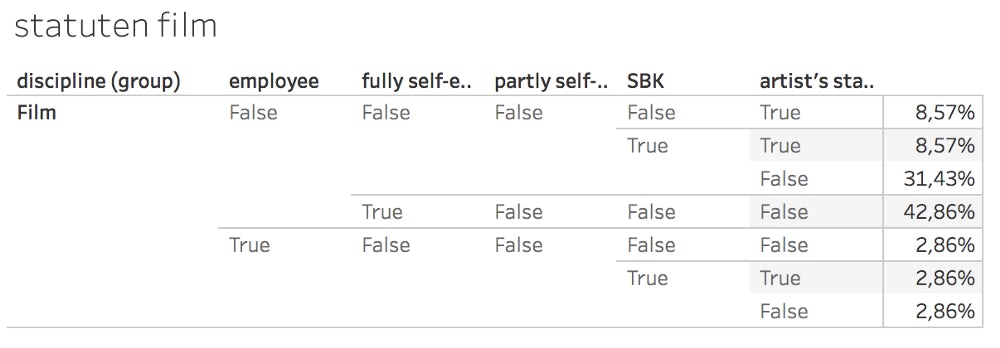
3.3 Perfroming arts
Also in performing arts, short contracted actors, dancers and technicians reach up to 46%, of which one quarter (12% in total) is not protected by other statutes or regulations. The rest combines these short contracts with an employee statute and/or they can rely on the artists’ statute, but it’s important to add that this artist’s statute also can get under pressure by the lockdown, because artists have to work enough days to keep it. 30% is fully self-employed.
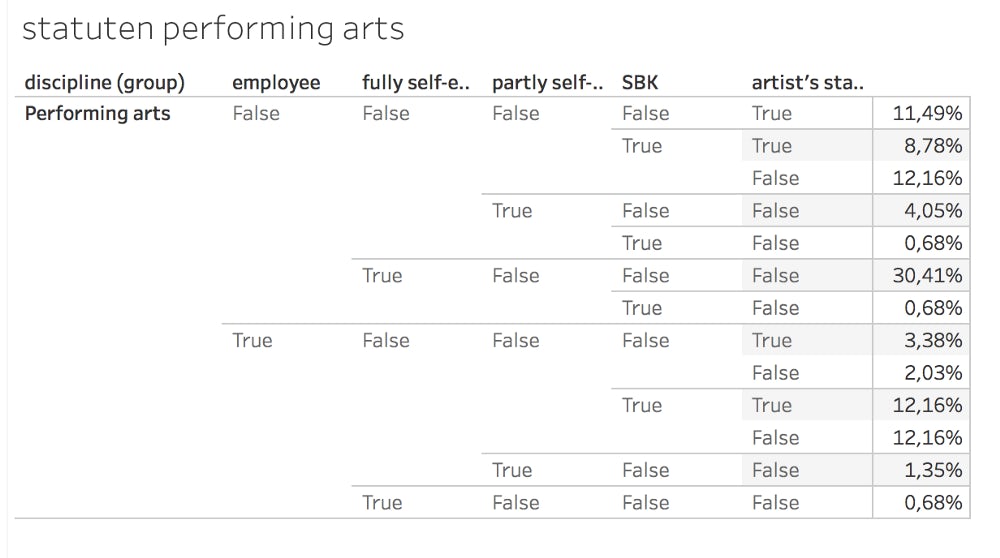
3.4 Music
Also in music the situation is complex. Half of the musicians are self-employed, fully or partly. The group that can not rely on any other support, except for temporary unemployment if the RVA is flexible, is 12%. In combination with other statutes, the group of musicians working with short contracts is 25%.
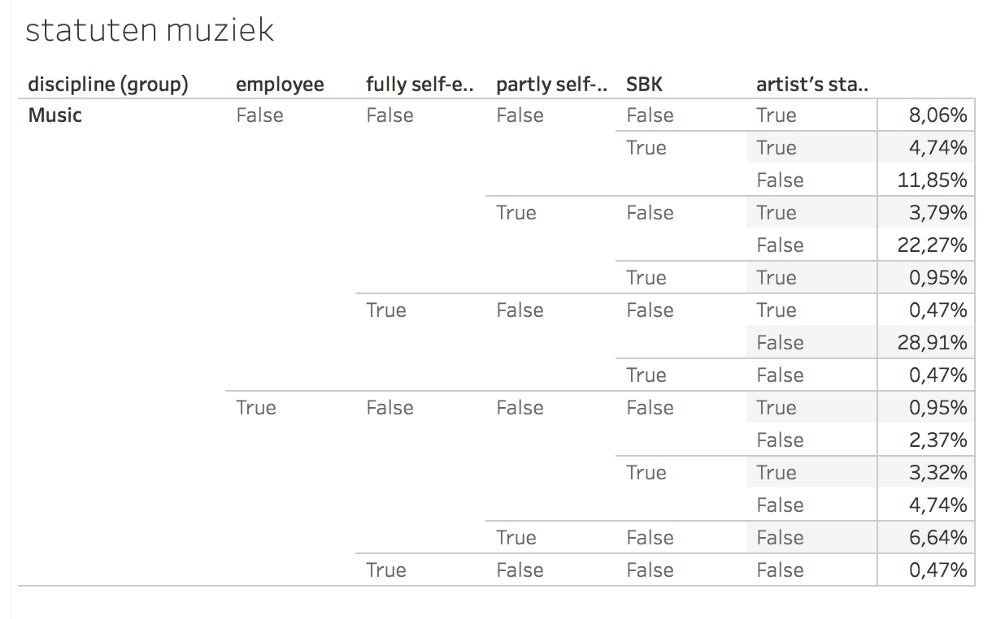
3.5 Visual arts
Also in visual arts, 52% of the artists and photographers are (mostly fully) self-employed, but another 26% only works via SBK’s (and only a very small percentage of them has the artists’ statute).
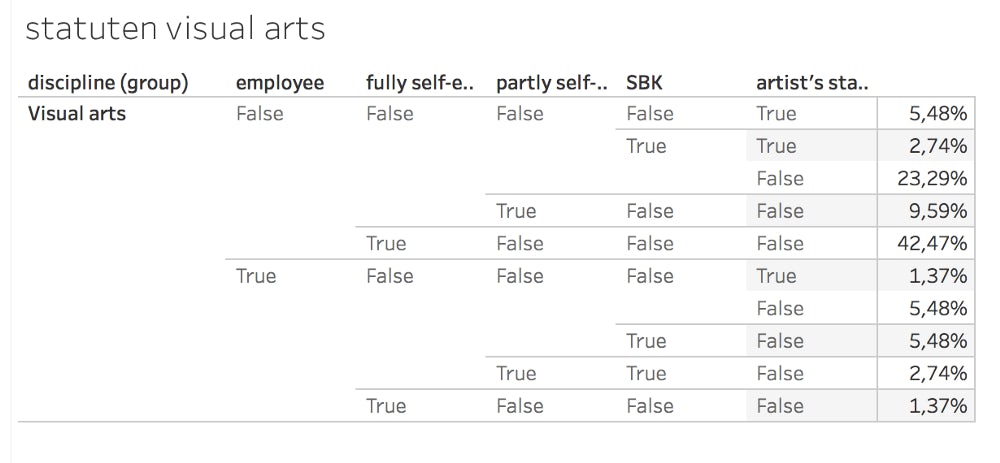
=> This means that the most vulnerable group of people working with short contracts, without any other statute to rely on, is the biggest in film and television (31%) and in visual arts (23%). In music and performing arts, they count for 12%. In literature they are about 6%. These are the freelance cultural workers that are possibly not (yet) benefitting from the special social support that is offered today to survive the cultural lockdown financially.
4. Which statutes are losing how much?
If we now link the statutes to the reported lost revenues, we get the following picture:
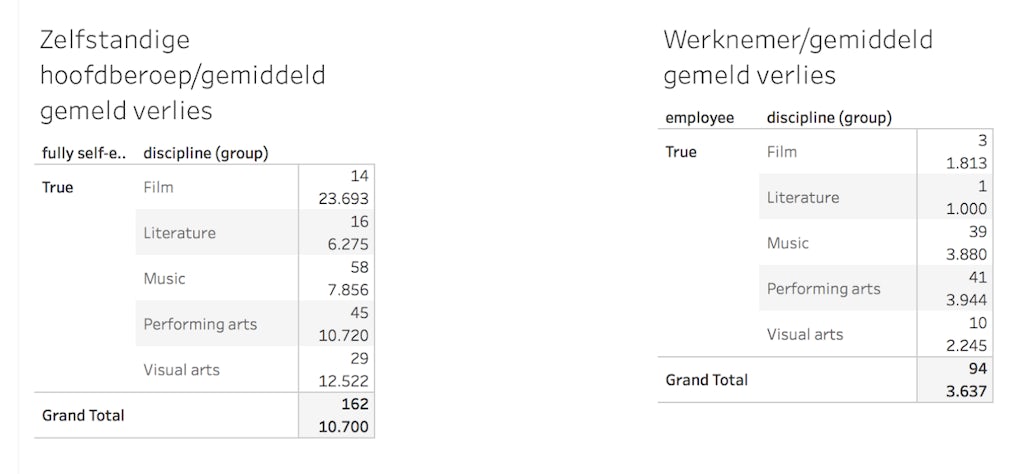
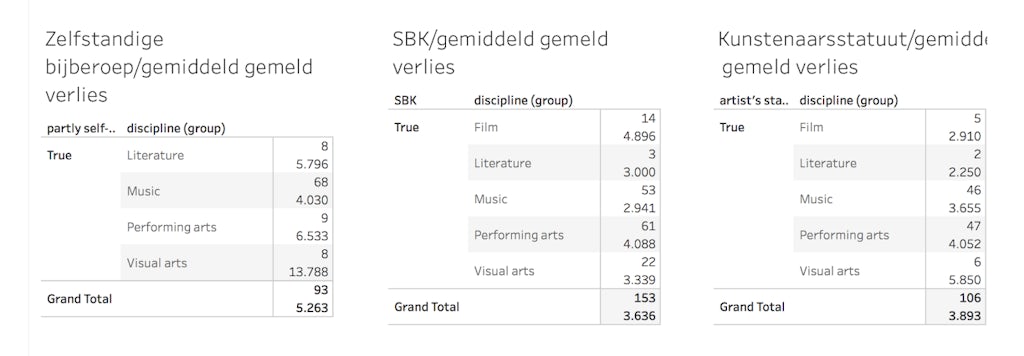
The biggest group of fully self-employed cultural workers (31%) also loses most money: 10.700 euro gross in average. They can apply for the ‘overbruggingsrecht’, which is 1.291 euro (or 1.614 euro with dependent family) per month, for March and April. So they will only be compensated for (in average) 24% to 30% of their lost revenues. If they lose 60% of their income in comparison with the same period last year, they can apply for another 3.000 euro compensation fee. In that case they recuperate 52% to 58%.
Also partly self-employed cultural workers (mostly musicians) can apply for these support regulations, but the conditions are quite strict for cultural freelancers in this statute: in reality only some of them pay social security taxes on the minimum level of full-timers. If they don’t pay social security but have an income in between 6.996 and 13.994 euro per year, they can get a one-time forfait (‘compensatiepremie’) of 1.500 euro. Given that the reported lost revenue by this group is 5.263 euro in average, that support counts for 28%.
Employees and cultural workers with the artist’s statute, report a similar average amount of lost revenues: between 3.600 and 3.900 euro. Performing and visual artists in these statutes lose more. Their unemployment benefits will only compensate a part of these losses.
Also cultural freelancers with short contracts via SBK’s report a similar average amount of lost income: 3.636 euro. Also here performing artists (the biggest disciplinary group in this statute) lose more, but it’s people working in the film and television field who lose the most: 4.896 euro in average. Whether this lost income is (partly) compensated for every case within this (often already precarious) group is still part of discussions on the political level. If not, social dramas for artists of all disciplines are waiting to happen.





